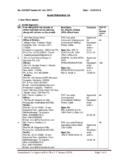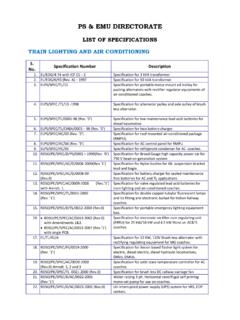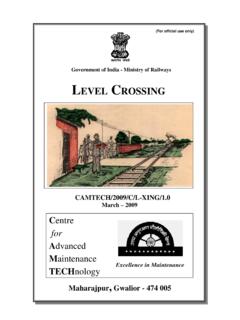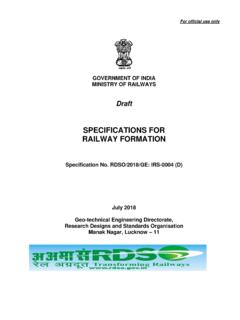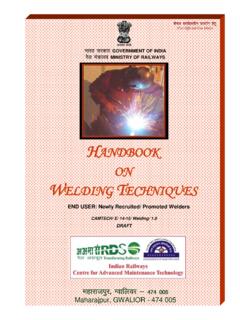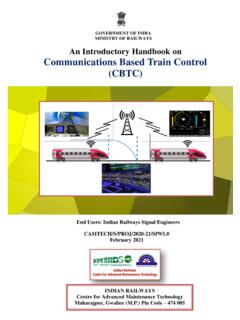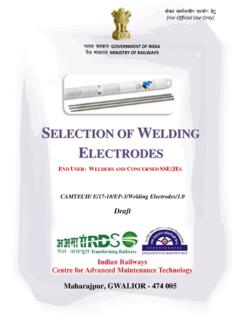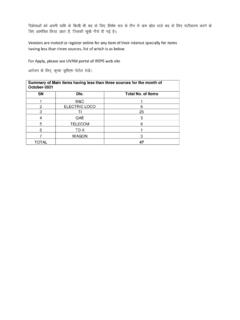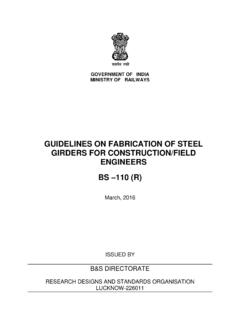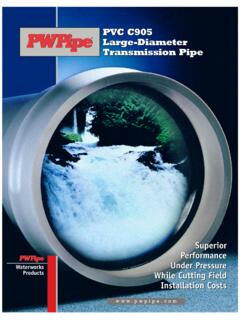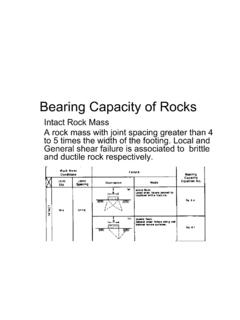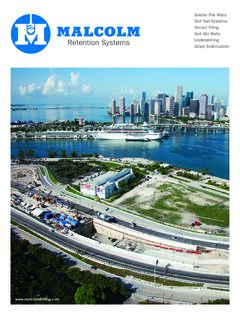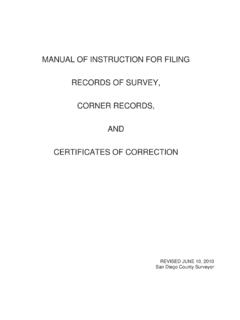Transcription of Guidelines on Construction & Maintenance of Borewells and ...
1 G O V E R NME NT O F IN DIA Hkkjr ljdkj MINIS T R Y O F R A IL WA Y S jsy ea=ky; Guidelines on Construction & Maintenance of Borewells and Tubewells Report No. : WKS-01-2014 January ,2014 Works Directorate dk;Z funs kky; Research Designs And Standards Organisation, Lucknow 226011 vuqla/kku vfHkdYi vkSj ekud laxBu y[ku 226011 FOR OFFICIAL USE ONLY PREFACE The subject, Construction and Maintenance of Borewells and tubewells is of considerable importance to the field officials who are engaged in this aspects of work of the civil engineering department.]
2 It is the responsibility of Civil Engineering Department to arrange adequate supply of water of acceptable quality to Railway premises. In Indian Railways mostly water is supplied by drawing underground water through tubewells. This guideline aims to bring together relevant details for the field engineers which are available in scattered form in various text book, handbooks, codes and manuals. It is hoped that engineers in the field connected with this subject will find a useful source of knowledge and guidance . An efficient water supply scheme leads to customer and staff satisfaction. These schemes require heavy investments.
3 Hence, there is an imperative need for proper planning and execution of such works. If there are any suggestions for improving the book or if any error/discrepancy is noticed in its contents, kindly write to the undersigned. Nand Kishore Sr. Executive Director / Works Index S. No. Description of Items Page No. 1. Introduction 1 2. Availability of water 1 3. Aquifers and aquicludes 2 4. Confined and unconfined aquifers 2 5. Classification of Borewells 3 6. Common shortcomings in design, Construction and management of Borewells 3 7. Construction of borewell 5 8. Design considerations for Borewells 10 9. Classification of formation material 14 10.
4 Sanitary seal and sealing of intake aquifer 15 11. Development 17 12. Disinfection of newly constructed Borewells 17 13. Yield test and determination of the discharge capacity of the pump for optimum performance 17 14. Approval of site plan, preliminary and final designs, and installation, testing and commissioning 19 15. Quality of water 20 16. Handing over of tubewell 21 17. Maintenance of borewell 25 18. Plugging abandoned wells 27 19. Troubleshooting guide 28 DO s & DONOT s 31 Bibliography 32 Page 1 of 32 Introduction : The water demand is met from a suitable source. This source should satisfy the requirement in terms of quantity as well as quality.
5 The usual sources of supply of water are rivers, canals, lakes, ponds, and wells etc. Railway may have its own arrangement for collecting water or may depend on local government resources for supply of full or partial requirement of water. It is the responsibility of Civil Engineering Department to arrange adequate supply of water of acceptable quality to Railway premises. To discharge this responsibility, it is essential to assess the requirements of water supply. The yardsticks for assessing the water requirement are laid down in Para 504 of Indian Railways Works Manual (IRWM). Availability of water: The water availability and the associated features and constraints are as follows: a) Surface water Surface water is water in river, lake or fresh water wetland.
6 Surface water is naturally replenished by precipitation and naturally lost through discharge to the oceans, evaporation, evapo-transpiration and sub-surface seepage. Although the only natural input to any surface water system is precipitation within its watershed, the total quantity of water in that system at any given time is also dependent on many other factors. These factors include storage capacity in lakes, wetlands and artificial reservoirs, the permeability of the soil beneath these storage bodies, the runoff characteristics of the land in the watershed, the timing of the precipitation and local evaporation rates.
7 All these factors also affect the proportions of water lost. Human activities can have a large impact on these factors. These often include increase in storage capacity by constructing reservoirs and decrease by draining wetlands, increase in runoff quantities and velocities by paving areas and channelizing stream flow. Also surface water may be lost or become unusable through pollution. b) Under river flow Throughout the course of the river, the total volume of water transported downstream will often be a combination of the visible free water flow together with a substantial contribution flowing through sub-surface rocks and gravels that underlie the river and its floodplain called the hyporheic zone.
8 For many rivers in large valleys, this unseen component of flow may greatly exceed the visible flow. The hyporheic zone often forms a dynamic interface between surface water and ground water, receiving water from the ground water when aquifers are fully charged and contributing water to ground water when ground waters are depleted. c) Ground water - Sub-surface water, or groundwater, is fresh water located in the pore space of soil and rocks . It is also water that is flowing within aquifers below the water table. Sometimes it is useful to make a distinction between sub-surface water that is closely associated with surface water and deep sub-surface water in an aquifer.
9 Page 2 of 32 Sub-surface water can be understood in the same terms as surface water, in terms of inputs, outputs and storage. The critical difference is that due to its slow rate of turnover, sub-surface water storage is generally much larger compared to inputs than it is for surface water. This difference causes a tendency to use sub-surface water unsustainably for a long time. However, it should be noted that the natural input to sub-surface water is seepage from surface water and this source is not infinite. However, the input to a sub-surface water source can be increased by building reservoirs or detention ponds. d) Desalination Desalination is an artificial process by which saline water (generally sea water) is converted to fresh water.
10 The most common desalination processes are distillation and reverse osmosis. Desalination is currently expensive compared to most alternative sources of water. It may be economically viable only for high-valued uses, such as household and industrial uses, in arid areas. Aquifers and aquicludes: The layers of soil and rock below the water table are classified in two broad categories: Aquifers Aquicludes. Aquifers are water bearing layers (or formations) that yield water to wells in usable amounts. Typical aquifers are made of sand, gravel or sandstone. These materials have large interconnected pore spaces between grains that water moves freely.
